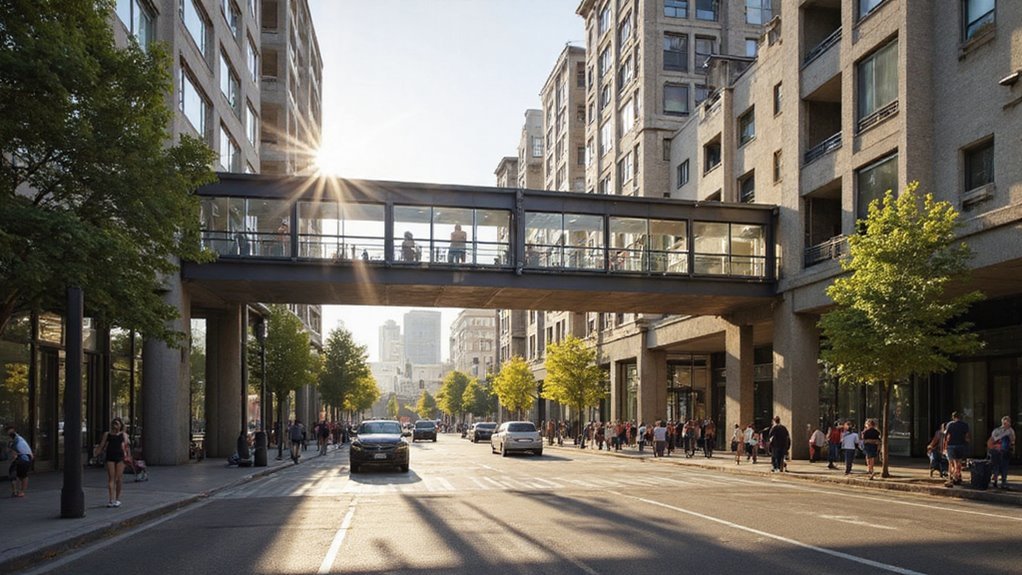You can snag high LTV bridge financing for mixed-use properties when traditional lenders give you the cold shoulder. These loans let you acquire and stabilize resi-commercial projects quickly while keeping your cash locked and loaded for renovations and lease-ups. You’ll typically get 65-80% LTV with 9-12% interest rates, interest-only payments, and flexible underwriting focused on your exit strategy rather than your credit score. Stick around to find out how you can actually make that work for your deal.
Key Takeaways
- Bridge loans provide 65-80% LTV financing for mixed-use properties when traditional lenders decline funding requests.
- Interest-only and deferred payment structures preserve cash for renovations while minimizing monthly costs during construction.
- Asset-based underwriting prioritizes exit strategy and property potential over credit scores for resi-commercial deals.
- Quick closing times enable competitive acquisition and rapid capital deployment for mixed-use stabilization projects.
- Pre-refinancing with conventional lenders upon stabilization prevents balloon payment defaults and secures long-term financing.
What Are Bridge Loans and How Do They Work?

You’re fundamentally borrowing against what the property *will be* after renovation. Once you’ve stabilized the asset through repairs and tenant leasing, you refinance into conventional financing. It’s the escape hatch when traditional lenders won’t budge and your deal can’t wait. Bridge loans provide short-term interim financing to bridge the gap until permanent funding is secured.
Loan Terms, Amounts, and Interest Rate Structure
While bridge loans are the financial speedboat that gets you toward the deal, the terms and rates are what actually determine whether you’re making money or just treading water. You’re typically looking at loan to value ratios between 65-80%, meaning the lender funds a significant chunk of your project’s potential value, not just its current condition. Interest-only payments keep your monthly costs lean during construction—usually 9-12% annually, which sounds steep until you realize the equity you’re creating. The flexible underwriting criteria mean lenders focus on your exit strategy and property potential, not just your credit score. Yes, higher interest rates exist, but they’re simply the transaction cost for speed and certainty when traditional banks won’t budge. However, it is vital to be aware of potential downsides that can arise with commercial bridge financing to avoid unexpected pitfalls.
LTV Ratios and Financing Limits for Mixed-Use Properties
The magic number that separates a fundable deal from a pipe dream is your loan-to-value ratio—the percentage from the property’s potential worth that a lender’ll actually give you. For mixed use financing, you’re typically looking at 65–80% LTV based on the after-repair value, not today’s distressed state. Here’s the breakthrough: bridge lenders‘ll push higher LTV ratios than traditional banks because they’re banking on your renovation vision, not just current comps. This aggressive short-term funding approach fills the funding gaps that conventional lenders won’t touch. Nevertheless, lower LTV ratios protect you from equity erosion if unexpected costs pop up during construction. The ideal location? Aim for 70% LTV. You’ll access enough capital to reshape the property while maintaining a safety cushion for those inevitable surprises. Keep in mind that bridge loans feature a short-term financing period typically lasting up to one year, allowing for faster access to capital in transitional real estate projects.
Eligibility Requirements and Underwriting Standards

Now that you’ve got a handle around how LTV ratios function and why 70% resides in that sweet area, it’s time for you to comprehend what actually secures you approved for that mixed use bridge loan in the initial place. Here’s the reality: private money lenders don’t care about your credit score like traditional banks do. Instead, they’re utilizing asset-based underwriting, which implies they’re valuing your property’s after-repair condition, not your personal finances. You’ll need solid exit strategy documentation, proof of contractor experience, and detailed renovation plans. A private money lender wants to see that you’ve got skin in the game and a realistic path toward refinancing. That’s what distinguishes serious investors from dreamers. When considering your options, it’s critical to understand the nuances of financing for multifamily properties to structure your investment effectively.
Credit Score Flexibility and Borrower Qualifications
Because traditional banks obsess over your three-digit credit score like it’s a crystal ball predicting your entire financial future, bridge lenders take a revitalizing different approach—they’re looking at what you’re actually building, not whether you missed a payment in 2019. Lenders for mixed use properties focus instead regarding your deal’s fundamentals: the property’s after-repair value, your renovation timeline, and your exit strategy. Yes, they’ll check your credit, but a score below 700 won’t automatically disqualify you. What matters more is your debt service coverage ratio and whether your project generates real cash flow. Bridge lenders understand that credit score flexibility opens doors for serious builders with solid plans. They’re betting upon your vision and execution, not your past mistakes. Current multi-family financing rates also influence bridge loan terms, making it essential to understand prevailing interest conditions when structuring your deal.
Key Benefits of Bridge Financing for Resi-Commercial Projects
What makes bridge financing the secret weapon for resi-commercial developers? You’re not stuck waiting for traditional banks to maybe approve your project. Instead, you can close deals in weeks, not months, giving you a competitive edge that actually matters.
Bridge financing reveals value-add opportunities by providing the capital improvement funds you need upfront. You can convert that vacant mixed-use space into something profitable before refinancing into conventional loans. Your mixed use renovation financing options suddenly expand because you’re not limited by conservative bank underwriting standards.
Here’s the real magic: you’re fundamentally buying equity at a discount. You identify the property’s potential, secure bridge capital to execute your vision, and watch the numbers work in your favor. Speed along with transformation equals serious returns. Additionally, bridge loans often feature interest-only payments during the term, helping to maximize cash flow while improvements are underway.
Common Applications in Mixed-Use Real Estate Development

Mixed-use bridge loans aren’t just theoretical tools—they’re the workhorses behind real changes happening in cities and towns right now. You’ll find them fueling downtown revitalizations where short-term funding lets you snatch properties before competitors even submit offers. When investors acquire mixed-use properties—think converted office buildings becoming residential lofts with ground-floor retail—bridge loans cover gaps between purchase and stabilization. They’re your secret weapon for property acquisition when traditional banks drag their feet. You’re not waiting months for approval; you’re closing in weeks. Whether you’re converting a shuttered mall into apartments or changing old commercial space into lively neighborhoods, bridge loans give you the quickness and capital to execute vision more swiftly than the banking system allows. That’s where real estate innovation happens. Additionally, leveraging 100% financing options can empower investors to flip houses or develop properties without any down payment, making bridge loans even more accessible and impactful.
Interest-Only Payments and Cash Flow Management
When you’re in the thick surrounding renovations, you don’t want your loan payments draining the cash you need for contractors and materials—which is exactly why interest-only payments during construction are your financial lifeline. You’ll structure your bridge loan so you’re paying just the interest while the work happens, keeping your reserves intact for the actual change, and then you’ll pivot toward a refinance before that balloon payment comes due. It’s basically the difference between sweating every dollar and actually having breathing room to build something worth millions.
Preserving Cash During Construction
Since you’re burning through capital more quickly than a construction crew burns through coffee, interest-only payments during the renovation phase aren’t just a nice feature—they’re your financial lifeline.
Here’s why this matters for your short-term funding strategy:
- Lower monthly obligations free up cash for actual construction costs and contingencies
- Gap funding becomes manageable when you’re not paying principal alongside labor bills
- Renovations increase property value more rapidly when you’ve got breathing room in your budget
- Refinancing pays off bridge loans smoothly once stabilization hits
You’re fundamentally preserving liquidity for what actually alters the property. Instead of watching your reserves evaporate to loan payments, you’re investing in the asset itself. That’s the real breakthrough. When the property stabilizes and hits that equity milestone, you refinance and move on—keeping your cash intact.
Payment Flexibility and Structure
The real magic behind a bridge loan isn’t just that this loan gets you the money—it’s how you structure the payments so you’re not bleeding cash while your construction crew is bleeding your budget. Interest-only payments are your lifeline during renovation, keeping monthly obligations razor-thin while you’re altering the property. With collateral-focused lending, lenders care about what you’re building, not your perfect credit score.
| Payment Type | Monthly Cost | Cash Flow Impact |
|---|---|---|
| Interest-Only | $3,500 | Preserves working capital |
| Deferred Interest | $0 | Maximizes liquidity |
| Partial Amortization | $5,200 | Moderate flexibility |
| Balloon Structure | $2,800 | Front-loaded savings |
| Hybrid Model | $4,100 | Balanced approach |
Your short term funding buys breathing room. Structure payments around your clear exit strategy—refinancing once stabilization hits. This payment flexibility changes a cash crunch into cash control, letting you invest profits back into your project rather than enhancing your lender unnecessarily.
Refinancing Before Balloon Maturity
Your exit strategy hinges around timing. Here’s what separates winners from those scrambling at the last minute:
- Monitor current mixed-use bridge loan rates constantly—they’ll guide your refinancing window
- Lock in conventional financing the moment your property stabilizes and shows cash flow
- Maximize speed in execution by pre-qualifying with traditional lenders before completion
- Build in a 60-90 day buffer before maturity to avoid desperate negotiations
The trick? Don’t wait until month 23 of your 24-month term. Refinance at month 18 when you’ve got advantage and breathing room.
Risk Factors and Exit Strategy Planning
You’ve got to face the reality that bridge loans come with a balloon payment waiting at the finish line, and that’s where most borrowers get blindsided if they haven’t planned their exit strategy ahead of schedule. Your job isn’t just to renovate the property and hope everything works out—you need a clear roadmap for how you’ll refinance into permanent financing, sell the asset, or find another way to cover that lump sum before it becomes due. Think about it like knowing your escape route before you even enter the building; without one, you’re stuck paying punishing interest rates for borrowed time.
Balloon Payment Preparation
Envision this: you’ve got 18 months left in your bridge loan, the renovation’s almost done, and suddenly your refinance lender gets cold feet because the market shifted. Now you’re staring down a balloon payment you weren’t prepared for. This is where smart planning saves your deal.
Your mixed-use bridge loan’s short maturity dates demand aggressive preparation. Here’s what you need:
- Build a refinance timeline – start conversations 6-9 months before maturity
- Stack backup lenders – never rely on one exit strategy with interim financing
- Document everything – rental income, occupancy rates, and property improvements prove value
- Negotiate extension options – that quarter-point fee beats defaulting hard
Rapid closing times got you the deal. Now make sure your exit strategy’s equally swift.
Exit Strategy Development
Three things’ll kill a bridge loan deal more quickly than a construction delay: no backup exit plan, underestimating how long refinancing actually takes, and pretending market conditions won’t shift against you. Your equity secures the financing, but the exit strategy development that keeps you alive. Once borrowers stabilize assets through renovation and leasing, the refinance pivot becomes your lifeline. Don’t assume banks’ll automatically fund you just because the property looks better now. Have three exit options ready: conventional refinancing, portfolio lending, or even a strategic sale. Map out timelines conservatively—add three months to everything. Your bridge lender expects you to have a clear path out before you sign anything.
Comparing Bridge Loans to Traditional Permanent Financing
a traditional bank loan is like waiting in line at the DMV, while a bridge loan is like cutting in front because your house is in flames.
Your mixed use bridge loan closes in weeks. A commercial mortgage takes months of underwriting, appraisals, and committee meetings. You need speed? Here’s what separates them:
- Timeline: Bridge loans close in 14 days; traditional financing takes 60-90 days
- Flexibility: Hard money loans work with distressed properties; banks demand perfection
- Approval rates: Quick closing happens because lenders focus on asset value, not credit scores
- Cost structure: Higher rates ($9-12%) offset by equity gains traditional lenders miss
You’re not paying for money. You’re paying for the ability to move initially, alter the property, then refinance into inexpensive permanent debt once stabilized.






